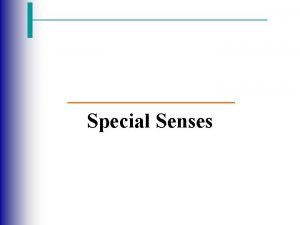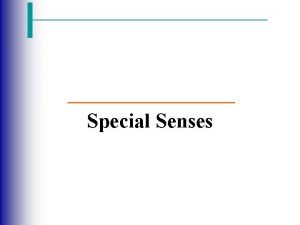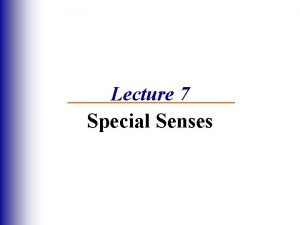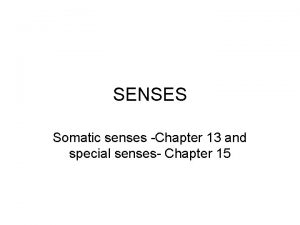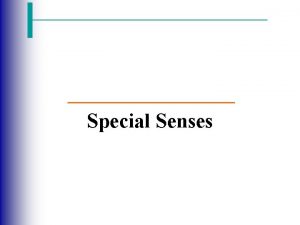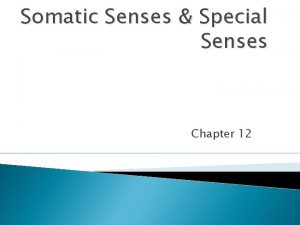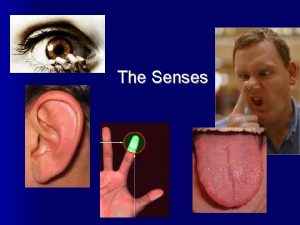The Senses Senses in Animals Survival Used for
















- Slides: 16

The Senses

• Senses in Animals • Survival – Used for survival to tell animals what is going on around them Sense organs Ears, nose, tongue, skin, eyes

• Senses in Animals • Planarian – Lives in ponds, rivers, and lakes – 2 sense organs • Knobs– used for detecting water currents • Eyespots– only able to tell light from dark

• Senses in Animals – Earthworms -light detectors -located just below the skin - Cricket Detects sound from the front of the leg Antennas detect feeling Uses a compound eye for seeing

• Senses in Animals – Snake • Snakes eyes are similar to human eyes • Snakes use their tongue to smell – They shoot their tongue out and it catches air molecules – They bring the air back into its mouth , where the sense of smell organ is located

Human Sense Organs • The Eye – Path of light through the eye • • Sclera Iris Pupil Cornea Lens Retina Vitreous humor

• The eye – Light passes and bends first through the cornea – Then light passes through the pupil and the lens • The light bends again in the lens towards each other Light then passes through the vitreous humor The vitreous humor is clear. The light finally reaches the retina

• The retina is made up of rods and cones – Rods detect motion and light or dark – Cones detect color • Cones are nerve cells that detect color • There are three types of cones, each type detects only one color-----red, green, or blue • All the other colors are cones acting together

• The optic nerve – Carries the message from the eye to the vision – Center of the brain • 2 things happen at the vision center – The brain interprets the message – The image is rotated right-side up

The Ear • 3 parts • Outer, Middle, Inner • Outer Ear • The only part that is visible of the entire ear • The ear flap helps direct the sound waves into the ear • Sound waves travel through the ear canal and bump against the ear drum

• Middle Ear – The vibration of the sound waves cause the anvil, hammer, and the stirrup to move – The stirrup is also connected to a membrane that vibrates with the motion of the ear bones

• Inner ear – The cochlea contains nerve cells that are connected to the auditory nerve • The auditory nerve takes the message to the brain to be interpreted • Semicircular Cells – Nothing to do with hearing – Helps maintain balance

The Tongue • The tongue contains taste buds that detect taste – They detect the chemical molecules in food – 4 different types • • Sour Salty Sweet bitter

The Nose • Detects gas molecules in the air • Neurons line the top of the nasal chamber • There are 7 different types of nerve cells in the nose that detect a different odor • The olfactory nerve takes messages to your brain and the cerebrum interprets the message

The Skin • 2 different layers for the skin – The epidermis –outside – The Dermis—inner part – 5 nerve cell types • • • Pain Pleasure Touch Heat Cold

• Most nerve cells are found in the dermis • But both the epidermis and the dermis share the pain cell • From the skin, the nerve cells travel to the cerebrum to be interpreted – They are perceived as cold, hot pain, pleasure, or touch
 State of survival survival of the fittest tweak
State of survival survival of the fittest tweak State of survival survival of the fittest stages
State of survival survival of the fittest stages Special vs general senses
Special vs general senses Distinguish between general senses and special senses.
Distinguish between general senses and special senses. Animals that eat both plants and animals
Animals that eat both plants and animals Https://a-z-animals.com/
Https://a-z-animals.com/ Consumers producers and decomposers
Consumers producers and decomposers Parasitic food chain example
Parasitic food chain example Castration equipment
Castration equipment Tack för att ni har lyssnat
Tack för att ni har lyssnat Smärtskolan kunskap för livet
Smärtskolan kunskap för livet Trög för kemist
Trög för kemist Argument för teckenspråk som minoritetsspråk
Argument för teckenspråk som minoritetsspråk Novell typiska drag
Novell typiska drag Mjälthilus
Mjälthilus Uppställning multiplikation
Uppställning multiplikation Delegerande ledarskap
Delegerande ledarskap



















